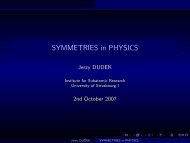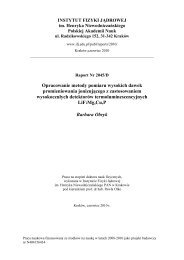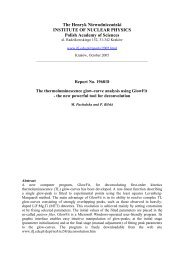Report No xxxx - Instytut Fizyki JÄ drowej PAN
Report No xxxx - Instytut Fizyki JÄ drowej PAN
Report No xxxx - Instytut Fizyki JÄ drowej PAN
Create successful ePaper yourself
Turn your PDF publications into a flip-book with our unique Google optimized e-Paper software.
ROLE OF THE CHELATING PROCESS OF FLAVONOIDS REDUCING<br />
THE INTERACTION BETWEEN ORGANOMETALLIC COMPOUNDS<br />
AND THE LIPID BILAYER – AS INFERRED<br />
FROM THE 1H-NMR STUDY<br />
1 Janina Gabrielska, 2 Monika Soczyńska–Kordala, 1 Stanisław Przestalski<br />
1 Department of Physics and Biophysics, 2 Department of Food, Vegetables and Cereals,<br />
Agricultural University, 50-375 Wrocław, <strong>No</strong>rwida 25, Poland, jaga@ozi.ar.wroc.pl<br />
The toxicity of organic tin compounds (OC) with respect to biological membranes<br />
depends, among others, on the degree of adsorption in the lipid phase of the membrane. The<br />
ionic forms of organometallic compounds, once localized in the membrane bilayer, interact<br />
with the polar membrane region [Kaszuba and Hant, 1990; Gabrielska et al., 1997]. It seems<br />
possible that the interaction may decrease when the OC molecules are engaged in a donoracceptor<br />
interaction leading to the formation of associates. As ligands in the complexes can<br />
occur, e. g., natural compounds of the flavonoid family, such as kempferol, quercetin and<br />
mirycetin (FL) [Morel et al., 1998; Dyba et al., 1999; Cornard and Merlin, 2001].<br />
The present work determines the degree of the interaction between equimolar mixtures<br />
of selected organometallic compounds (dichloro-diphenyltin – DPhT and chlorides of<br />
triphenyltin – TPhT and triphenyllead – TPhL, with kempferol, quercetin, mirycetin) and the<br />
phosphate grouping of the phosphatidylcholine (PC) liposome membrane. That interaction<br />
was compared with both FL and OC compounds interacting alone with that grouping. As a<br />
parameter of the interaction was assumed the competitive release of praseodymium ions (Pr 3+ )<br />
from membranes induced by the compounds studied, measured with the proton nuclear<br />
magnetic resonance (H 1 -NMR) method.<br />
The results obtained allow to conclude that, as a result of chelating by FL the ionic<br />
forms of OC compounds, changes their coulombic interaction with phosphate group of the<br />
bilayer. Consequently, undergoes reduction also the degree of the competitive praseodymium<br />
ions release from the membrane bilayer by equimolar mixtures of FL with OC, compared with<br />
release of the ions effected by the compounds added separately. The decrease is especially<br />
conspicuous for mixtures of flavonoids with DPhT (ca. 90%), and much lower for mixtures of<br />
flavonoids with triphenyltin chlorides (ca. 40 %).<br />
Natural flavonoid compounds, such as kempferol, quercetin and mirycetin, due to their<br />
metal chelating properties [Cornard and Merlin, 2001; Soczyńska-Kordala et al., 2000], lead<br />
and tin including, constitute a good protection against the toxic forms of OC compounds<br />
acting on PC membranes.<br />
Work supported by KBN grant <strong>No</strong> 4 PO6 019 21<br />
1. Kaszuba M., Hunt G.R.A. (1990) A 1 H-NMR study of the influence of n-alcohols on the<br />
stoichiometry of melittin-induced permeability of phosphatidylcholine membrane. Biochim. Biophys.<br />
Acta 985, 106-110.<br />
2. Gabrielska J., Sarapuk J., Przestalski S. (1997) Role of hydrophobic and hydrophylic interactions of<br />
organotin and organolead compounds with model lipid membranes. Z. Naturforsch., 52c, 209-216.<br />
3. Dyba M., Solinas S, Caleddu N, Ganadu M-L, Kozłowski H. (1999) Cu(II) complexes with rutin.<br />
Polish J. Chem., 73, 873-878.<br />
4. Morel I., Cillard P., Cillard J. (1998) Flavonoid-metal interactions in biological systems.<br />
In:Flavonoid in health and disease. Eds. C. Rice-Evans, L. Parcker, Marcel Dekker. INC, New York,<br />
Basel, pp. 163-176.<br />
5. Cornard J.P., Merlin J.C. (2001) Structural and spectroscopic investigation of 5-hydroksyflavone<br />
and its complex with alumunium. J. Mol. Struc., 569, 129-138.<br />
6. Soczyńska-Kordala M., Gabrielska J., Bąkowska A, Przestalski S. (2000) Biochem Biophys. Mol.<br />
Lett.<br />
28

















